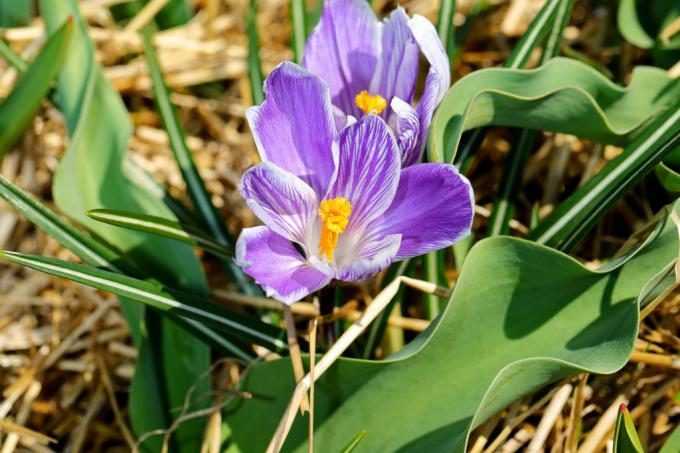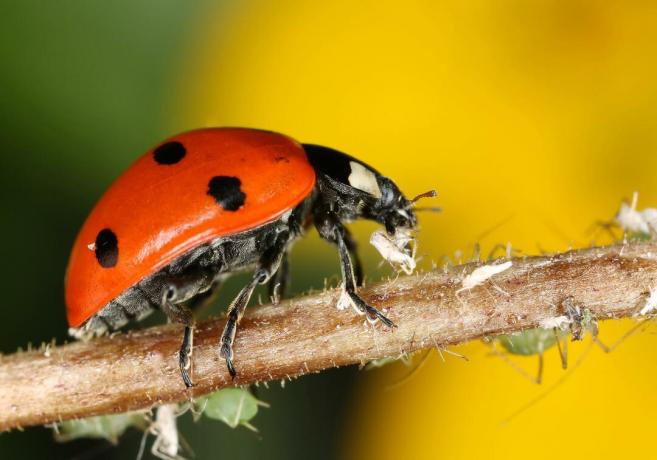Gardening is not necessarily the cheapest hobby. For real bargain hunters, we have 10 tips on affordable gardening ready.

Even if it doesn't look like it at first glance, you can actually spend a lot of money on your own hobby garden. Especially new plants, but also fertilizer, tools or even the water for sprinkling the lawn can put a lot of strain on the wallet and therefore put off many gardening beginners. But there is another way: with a few simple tricks, even bargain hunters can create a spectacular garden and create a real feel-good paradise with little money.
Gardening doesn't always have to be expensive - here you can find out which tricks can really save you money.
contents
- 1. New plants at a low price
- 2. The right plants for the cheap garden
- 3. Propagate plants yourself
- 4. Regrowing
- 5. Rain butt instead of tap water
- 6. Use kitchen waste
- 7. Make earth yourself
- 8. Fight off pests naturally
- 9. Own vegetables
- 10. Old becomes new
1. New plants at a low price
It can quickly become expensive, especially when creating a new garden. New plants and flowers in particular are a burden on the wallet and almost break the budget. However, you can save a lot of money with simple tricks - seeds or flower bulbs often cost significantly less than mature plants. You can get a real bargain here, especially when it comes to lawns, because grass seeds are not only cheaper than turf, but they can also be wonderfully mixed with wildflower seeds. This not only creates a paradise for insects in a very short time, but also a real feast for the eyes. If you don't feel like waiting for beautiful plants to bloom from small seeds, you can get some bargains at plant swap markets. Many congregations usually offer these meetings in spring and autumn. Here you can find young plants and offshoots of some rare or old varieties that hobby gardeners give in exchange or for little money.

2. The right plants for the cheap garden
When deciding on new plants, one should not only pay attention to the price, but also to the choice of the right plant varieties. So are annuals Summer flowers not a good plant - although the colorful plants do not cost much, they have to be bought and sown every year. On the other hand, one is better served with perennial, hardy perennials. With good care, these drift out every year and not only save your wallet, but also save working time. Bulb flowers also offer a great alternative, because they tend to grow wild and within a few years they form a wonderful carpet of flowers that will give you long-term pleasure. If you want to buy cheap flower bulbs, you should stop by the garden center from November: Because they Tubers have a limited shelf life, at which point they often come at bargain prices submitted.
3. Propagate plants yourself
Anyone who regularly buys new plants to top up their garden has to spend a lot of money. On the other hand, it is cheaper to propagate your own plants yourself. This is particularly easy with perennials and grasses: By dividing - either with your hands or with a spade, depending on the size - you can easily create offshoots of the plant. In addition, the division is a real fountain of youth for perennials that have grown rotten. In the case of annual summer flowers, the ripe seed heads can be collected in late summer. When stored in a dark, dry and airy place - for example in sandwich bags - the seeds can be kept over the winter and re-sown in the spring. But also vegetables like Cucumber (Cucumis sativus), Green beans (Phaseolus vulgaris) or tomatoes (Solanum lycopersicum) can be traced by collecting the seeds that are hidden inside.
4. Regrowing
Grow plants from vegetable scraps? That's fine - "Regrowing" is the name of the new trend with which you not only avoid waste, but also save real money. But anyone who thinks that this is a complicated matter is wrong - in fact, the implementation of this concept is Child's play: Simply put the stalk that you would otherwise throw away in a glass with water and change the water regularly. As soon as the germ begins to sprout, the small plant can be placed in the bed intended for it. Especially leek (Allium ampeloprasum subsp. ampeloprasum), Celery (Apium graveolens var. dulce) and romaine lettuce (Lactuca sativa var. longifolia) are suitable for regrowing. But you can also grow new plants from fruit pits - the exotic ones Planting mango is very easy, for example.
You can find step-by-step instructions for regrowing over 20 types of fruit and vegetables in the book "Regrow your veggies”By our Plantura co-founders Melissa Raupach and Felix Lill. The lovingly designed paperback also contains helpful tips on caring for the regrowing plants and practical recipe tips.
5. Rain butt instead of tap water
In hot summers in particular, gardeners increasingly use watering cans or turn on the lawn sprinkler. Unfortunately, this is also reflected in the water bill, because it is often underestimated how much water a green garden needs. Fortunately, nature provides us with water free of charge in the form of rain - we just have to catch it. Rain barrels and barrels are a great way to catch water in the rainy season so that the collected water can be used for watering when it is dry. When buying such a rain barrel, however, you should make sure that it has a stable cover and that the water surface is not freely accessible. This not only ensures that the barrel does not develop into a breeding site for annoying mosquitoes, But it can also bring life to small children, who are known to like to play and climb in the garden save.
6. Use kitchen waste
Many people put banana peels, coffee grounds and egg shells in the organic waste bin. But that doesn't have to be the case, because kitchen waste is actually an excellent substitute for fertilizer. Banana peels, for example, contain a lot of phosphate compounds and potassium, which is why they are a real insider tip for Fertilizing roses (pink) are. One Fertilize with dried coffee grounds however, is popular for orchids and also drives away snails and ants while Eggshell fertilizer are a great supplier of calcium. But the remaining organic waste should not end up in the bin either: this can be used together with garden waste compost make, which also makes a great fertilizer.

7. Make earth yourself
To ensure that their plants are optimally cared for, many gardeners use the potting soil packed in plastic bags. Unfortunately, this is not only expensive, but also not particularly climate-friendly due to its packaging and composition. On the other hand, it is cheaper and also more ecological, his Mixing compost yourself. With just a few materials and minimal effort, you can create a great foundation for your plants created by you that are also individually tailored to the needs of the individual varieties can be.
8. Fight off pests naturally
Many gardeners do not like pesticides because they are not only expensive but also harmful to the environment. Nevertheless, many resort to the chemical club when aphid and Co. make the garden unsafe. If you not only want to save money, but also want to protect the environment, you can also fall back on natural means: Beneficial insects again Ladybug or the Lacewing declare war on the little pests without paying if you can lure them into the garden. Beneficial animals feel particularly comfortable when they are given sufficient opportunities to retreat in the form of wild corners or insect hotels. If you don't want to rely on the power of beneficial insects, you can too old home remedies to grab: Nettle broth or an infusion Wormwood leaves can sometimes work wonders.

9. Own vegetables
You can save money not only in the gardening itself - real bargain hunters also save money in everyday life thanks to their garden. Fruit and vegetables do not have to be bought at a high price, they can also be grown in your own garden. And you don't even need a lot of space for that: tomatoes, Strawberries (Fragaria) or salad (Lactuca sativa) can even be grown on a balcony without any problems. If you don't want to create a separate vegetable patch, you can also plant your vegetables between the plants in the flowerbed: Swiss chard (Beta vulgaris subsp. vulgaris) or Ornamental cabbage (Brassica oleracea var. acephalad) not only provide a decorative eye-catcher here, the Have flowers as plant partners even a positive effect. So that you still have some of your harvest after the summer, it is worth taking precautions: potatoes (Solanum tuberosum) and Apples (Malus) can keep for several months if stored correctly, vegetables are wonderful durable by boiling and fruit can survive the winter canned or made into jam.
10. Old becomes new
Recycling has been a household trend for a long time - it's time for it to make its way into the garden. In fact, all sorts of things that are apparently superfluous can be reused in the garden. Newspaper or toilet rolls can be used as seed containers, for example. With a little skill, old pots or teapots can become effective eye-catchers in the garden as flower pots, glass bottles are wonderfully suitable as decoration. Even an old pair of jeans can still attract admiring glances: Simply tie the bottom with dirt fill and pose and put a plant on top - a creative eye-catcher is ready Saver price.
Grow new plants from kitchen waste? As Regrowing works, find out here.



